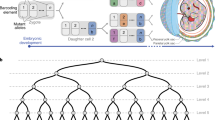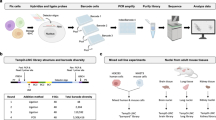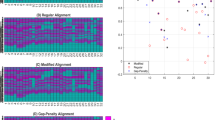Abstract
Lineage tracing is a powerful tool to study cell history and cell dynamics during tissue development and homeostasis. An increasingly popular approach for lineage tracing is to generate high-frequent mutations at given genomic loci, which can serve as genetic barcodes to label different cell lineages. However, current lineage tracing mouse models suffer from low barcode diversity and limited single-cell lineage coverage. We recently developed the DARLIN mouse model by incorporating three barcoding arrays within defined genomic loci and combining Cas9 and terminal deoxynucleotidyl transferase (TdT) to improve editing diversity in each barcode array. We estimated that DARLIN generates 1018 distinct lineage barcodes in theory, and enables the recovery of lineage barcodes in over 70% of cells in single-cell assays. In addition, DARLIN can be induced with doxycycline to generate stable lineage barcodes across different tissues at a defined stage. Here we provide a step-by-step protocol on applying the DARLIN system for in vivo lineage tracing, including barcode induction, estimation of induction efficiency, barcode analysis with bulk and single-cell sequencing, and computational analysis. The execution time of this protocol is ~1 week for experimental data collection and ~1 d for running the computational analysis pipeline. To execute this protocol, one should be familiar with sequencing library generation and Linux operation. DARLIN opens the door to study the lineage relationships and the underlying molecular regulations across various tissues at physiological context.
Key points
-
The DARLIN mouse enables the study of the cell lineages of millions of cells and at a high efficiency in vivo.
-
Compared with other lineage-tracing mouse models, which can suffer from low barcode diversity and limited single-cell lineage coverage, the DARLIN mouse incorporates three barcoding arrays within defined genomic loci and combines Cas9 and terminal deoxynucleotidyl transferase to improve editing diversity in each barcode array.
This is a preview of subscription content, access via your institution
Access options
Access Nature and 54 other Nature Portfolio journals
Get Nature+, our best-value online-access subscription
27,99 € / 30 days
cancel any time
Subscribe to this journal
Receive 12 print issues and online access
269,00 € per year
only 22,42 € per issue
Buy this article
- Purchase on SpringerLink
- Instant access to full article PDF
Prices may be subject to local taxes which are calculated during checkout








Similar content being viewed by others
Data availability
Raw and intermediate data associated with this tutorial can be obtained in https://zenodo.org/records/11929508.
Code availability
The snakemake_DARLIN package for DARLIN data processing is available at https://github.com/ShouWenWang-Lab/snakemake_DARLIN. The companion Python package for downstream analysis is available at https://github.com/ShouWenWang-Lab/MosaicLineage. A tutorial for downstream analyses written in jupyter notebooks can be found at https://github.com/ShouWenWang-Lab/DARLIN_tutorial.
References
Kretzschmar, K. & Watt, F. M. Lineage tracing. Cell 148, 33–45 (2012).
Bałakier, H. & Pedersen, R. A. Allocation of cells to inner cell mass and trophectoderm lineages in preimplantation mouse embryos. Dev. Biol. 90, 352–362 (1982).
Snippert, H. J. et al. Intestinal crypt homeostasis results from neutral competition between symmetrically dividing Lgr5 stem cells. Cell 143, 134–144 (2010).
He, L. et al. Enhancing the precision of genetic lineage tracing using dual recombinases. Nat. Med. 23, 1488–1498 (2017).
Liu, K. et al. Tracing the origin of alveolar stem cells in lung repair and regeneration. Cell 187, 2428–2445.e20 (2024).
He, L. et al. Proliferation tracing reveals regional hepatocyte generation in liver homeostasis and repair. Science 371, eabc4346 (2021).
McKenna, A. et al. Whole-organism lineage tracing by combinatorial and cumulative genome editing. Science 353, aaf7907 (2016).
Raj, B. et al. Simultaneous single-cell profiling of lineages and cell types in the vertebrate brain. Nat. Biotechnol. 36, 442–450 (2018).
Spanjaard, B. et al. Simultaneous lineage tracing and cell-type identification using CRISPR–Cas9-induced genetic scars. Nat. Biotechnol. 36, 469–473 (2018).
Alemany, A., Florescu, M., Baron, C. S., Peterson-Maduro, J. & van Oudenaarden, A. Whole-organism clone tracing using single-cell sequencing. Nature 556, 108–112 (2018).
Chan, M. M. et al. Molecular recording of mammalian embryogenesis. Nature 570, 77–82 (2019).
Kalhor, R. et al. Developmental barcoding of whole mouse via homing CRISPR. Science 361, eaat9804 (2018).
Pei, W. et al. Polylox barcoding reveals haematopoietic stem cell fates realized in vivo. Nature 548, 456–460 (2017).
Sun, J. et al. Clonal dynamics of native haematopoiesis. Nature 514, 322–327 (2014).
Pei, W. et al. Resolving fates and single-cell transcriptomes of hematopoietic stem cell clones by PolyloxExpress barcoding. Cell Stem Cell 27, 383–395.e8 (2020).
Weber, T. S. et al. LoxCode in vivo barcoding resolves epiblast clonal fate to fetal organs. Preprint at bioRxiv https://doi.org/10.1101/2023.01.02.522501 (2023).
Xie, L. et al. Comprehensive spatiotemporal mapping of single-cell lineages in developing mouse brain by CRISPR-based barcoding. Nat. Methods https://doi.org/10.1038/s41592-023-01947-3 (2023).
Liu, K. et al. Mapping single-cell-resolution cell phylogeny reveals cell population dynamics during organ development. Nat. Methods https://doi.org/10.1038/s41592-021-01325-x (2021).
Bowling, S. et al. An engineered CRISPR–Cas9 mouse line for simultaneous readout of lineage histories and gene expression profiles in single cells. Cell 181, 1410–1422.e27 (2020).
Li, L. et al. A mouse model with high clonal barcode diversity for joint lineage, transcriptomic, and epigenomic profiling in single cells. Cell https://doi.org/10.1016/j.cell.2023.09.019 (2023).
Wang, S.-W., Herriges, M. J., Hurley, K., Kotton, D. N. & Klein, A. M. CoSpar identifies early cell fate biases from single-cell transcriptomic and lineage information. Nat. Biotechnol. https://doi.org/10.1038/s41587-022-01209-1 (2022).
Wang, K. et al. PhyloVelo enhances transcriptomic velocity field mapping using monotonically expressed genes. Nat. Biotechnol. https://doi.org/10.1038/s41587-023-01887-5 (2023).
Jones, M. G. et al. Inference of single-cell phylogenies from lineage tracing data using Cassiopeia. Genome Biol. 21, 92 (2020).
Schiffman, J. S. et al. Defining heritability, plasticity, and transition dynamics of cellular phenotypes in somatic evolution. Nat. Genet. https://doi.org/10.1038/s41588-024-01920-6 (2024).
Patel, S. H. et al. Lifelong multilineage contribution by embryonic-born blood progenitors. Nature 606, 747–753 (2022).
Abdullah, L. et al. Hierarchal single-cell lineage tracing reveals differential fate commitment of CD8 T-cell clones in response to acute infection. Preprint at bioRxiv https://doi.org/10.1101/2024.03.21.586160 (2024).
Rodriguez-Fraticelli, A. E. et al. Single-cell lineage tracing unveils a role for TCF15 in haematopoiesis. Nature https://doi.org/10.1038/s41586-020-2503-6 (2020).
Rodriguez-Fraticelli, A. E. et al. Clonal analysis of lineage fate in native haematopoiesis. Nature 553, 212–216 (2018).
Weinreb, C., Rodriguez-Fraticelli, A., Camargo, F. D. & Klein, A. M. Lineage tracing on transcriptional landscapes links state to fate during differentiation. Science 367, eaaw3381 (2020).
Weng, C. et al. Deciphering cell states and genealogies of human hematopoiesis. Nature https://doi.org/10.1038/s41586-024-07066-z (2024).
Engblom, C. et al. Spatial transcriptomics of B cell and T cell receptors reveals lymphocyte clonal dynamics. Science 382, eadf8486 (2023).
Chen, A. et al. Spatiotemporal transcriptomic atlas of mouse organogenesis using DNA nanoball-patterned arrays. Cell 185, 1777–1792.e21 (2022).
Rao, A., Barkley, D., França, G. S. & Yanai, I. Exploring tissue architecture using spatial transcriptomics. Nature 596, 211–220 (2021).
Tian, L., Chen, F. & Macosko, E. Z. The expanding vistas of spatial transcriptomics. Nat. Biotechnol. 41, 773–782 (2023).
Beard, C., Hochedlinger, K., Plath, K., Wutz, A. & Jaenisch, R. Efficient method to generate single-copy transgenic mice by site-specific integration in embryonic stem cells. Genesis 44, 23–28 (2006).
Acknowledgements
The authors would like to thank F. Garcia Osorio for his work on developing the Cas9–CARLIN model and initial barcode amplification protocols. L.L. would like to thank H. Wu, a former research assistant in her laboratory, for plotting the schematic genetics of DARLIN mouse. S.-W.W. would like to thank M. Chen, a PhD student in his laboratory, for formatting this manuscript. S.-W.W. acknowledges support from Westlake High-Performance Computing Center. L.L. is supported by National Key Research and Development Project of China (2024YFA1306603). L.L. and S.-W.W. acknowledge support from ‘Pioneer’ and ‘Leading Goose’ R&D Programs of Zhejiang province (2024SSYS0034 and 2024SSYS0034). S.B. acknowledges support from the NIH (grant number 1K99HL164969). S.-W.W. acknowledges support from the NSFC (32470700). F.D.C. is funded by grants R01HL128850, RC2DK131963 and R01HL158192, and an Alex Lemonade Crazy 8 award.
Author information
Authors and Affiliations
Contributions
This protocol is based on a paper by L.L., S.B., S.-W.W. and F.D.C., where L.L. and S.B. developed the DARLIN model with input from F.D.C., and S.-W.W. developed and carried out computational analyses. Here, S.-W.W., L.L. and S.B. wrote the manuscript. H.L. helped to develop the analyses tutorial and generated Figs. 3 and 7 with supervision from S.-W.W.; and D.C. generated Figs. 2, 4 and 5 with supervision from L.L.
Corresponding authors
Ethics declarations
Competing interests
The authors declare no competing interests.
Peer review
Peer review information
Nature Protocols thanks Zheng Hu, Bushra Raj and the other, anonymous, reviewer(s) for their contribution to the peer review of this work.
Additional information
Publisher’s note Springer Nature remains neutral with regard to jurisdictional claims in published maps and institutional affiliations.
Key references
Li, L. et al. Cell 186, 5183–5199.e22 (2023): https://doi.org/10.1016/j.cell.2023.09.019
Bowling, S. et al. Cell 181, 1410–1422.e27 (2020): https://doi.org/10.1016/j.cell.2020.04.048
Patel, S. H. et al. Nature 606, 747–753 (2022): https://doi.org/10.1038/s41586-022-04804-z
Rights and permissions
Springer Nature or its licensor (e.g. a society or other partner) holds exclusive rights to this article under a publishing agreement with the author(s) or other rightsholder(s); author self-archiving of the accepted manuscript version of this article is solely governed by the terms of such publishing agreement and applicable law.
About this article
Cite this article
Li, L., Bowling, S., Lin, H. et al. DARLIN mouse for in vivo lineage tracing at high efficiency and clonal diversity. Nat Protoc (2025). https://doi.org/10.1038/s41596-025-01141-z
Received:
Accepted:
Published:
DOI: https://doi.org/10.1038/s41596-025-01141-z



